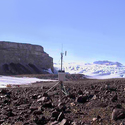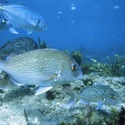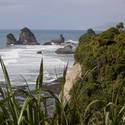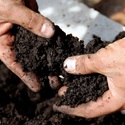If you dig a hole in your school playing field, will the soil there look the same as the soil in your home garden? Is soil the same all over New Zealand?
All soils have some things in common. They are all made of mineral1 particles, organic matter2, air and water – but soils are also different due to how and where they were formed.
Five factors influence soil formation: parent material, climate3, living organisms, topography4 and time.
Parent material
Living things inherit characteristics from their parents – and soils do the same. The rock from which a soil is formed is called parent material. Sometimes the parent material stays in the same place, while other parent materials are transported by wind, water or by other means. Parent materials also have different properties, for example, the amount of nutrients5. That means New Zealand soils that began as pumice6 from volcanic eruptions will be different to those that began as sediments7 deposited by rivers.
Climate
Climate refers to temperature8 and rain. Heating and cooling can speed up the weathering9 or breaking down of rocks into smaller pieces. Warm temperatures and rain encourage plants and animals to grow, adding organic10 matter11 to the soil. Rain also washes (transports) rocks and soil off slopes and can dissolve minerals, adding them to the soil.
Living organisms
Plant roots grow down into the soil. Roots get into cracks and release chemicals12 that help make nutrients available. Earthworms and other animals tunnel through soil and mix it up. When plants and animals die, they add organic matter to soil. Humans also make changes to soils. Removing vegetation13 from the top of soil exposes it to erosion14 – the soil can get blown or washed away. Humans add fertiliser15 to make soil more productive or lime16 to make it less acidic.
Topography
Topography refers to the land. If land is sloped, gravity17 moves soil particles downwards, deepening the soil in a valley. Topography also influences the climate. New Zealand weather18 patterns often come in from the west. The air cools as it rises up over the mountains, and the moisture in the air falls as rain. The air is drier by the time it reaches land in the east, so less rain falls.
Time
It takes a long time for soil to develop – from 500 to thousands of years for every 1–2 cm. The age of soils differs around the country. Parts of Northland have quite old soils, whereas the valleys in the Gisborne area have soils that are young – some were formed on material moved by Cyclone Bola in 1988.
Nature of Science
There are many everyday words that have a totally different meaning in science. When speaking about humans, the word ‘old’ may mean several decades. When speaking about soil, the word ‘old’ may mean thousands of years.
Activity idea
What makes up soil? uses an interactive or paper-based graphic organiser to explore student ideas about the components of soil.
Useful links
Visit Pātaka Oneone – the Manaaki Whenua19 Landcare Research soils portal. Resources are curated by topic – including Understanding soils and How do soils form?.
The New Zealand Society of Soil Science has created PDFs of the book Soils in the New Zealand Landscape: the Living Mantle. The chapter How soils are formed has extensive information and media on this topic.
- mineral: 1. (Geology) A naturally occurring solid formed through geological processes. Any given mineral has a characteristic chemical composition and a specific set of physical properties. 2. (Dietary) An inorganic compound needed for proper body function and maintenance of health, for example, iron in the form of haeme present in red meat.
- organic matter: The decomposed remains of living organisms and their waste products.
- climate: The weather conditions of an area averaged over a series of years, usually 30 or more.
- topography: The relief/natural features of the surface of the land. The study or detailed mapping of the surface of the land, especially the shape of its surface.
- nutrient: A substance that provides nourishment for growth or metabolism.
- pumice: A type of rhyolite rock found in New Zealand, particularly in the central North Island. It is light in colour, not heavy and often filled with holes.
- sediments: Material that settles to the bottom of a liquid. In geology, it describes the solid fragments of inorganic or organic material that come from the weathering of rock and are carried and deposited by wind, water or ice.
- temperature: A measure of the degree of hotness or coldness of an object or substance. Temperature is measured with a thermometer calibrated in one or more temperature scales. Kelvin scale temperature is a measure of the average energy of the molecules of a body.
- weathering: Chemical, mechanical (including freezing and thawing) and biological processes that break down rocks into smaller pieces. Weathering does not include the transport away of broken-down material.
- organic: 1. Molecules that contain carbon and that have a biological origin. 2. Grown using natural processes with nutrients from natural sources.
- matter: The basic structural component of all things that have mass and volume.
- chemicals: Everything is made up of chemicals. All matter (anything made of atoms) can be called chemicals. They can be in any form – liquid, solid or gas. Chemicals can be a pure substance or a mixture.
- vegetation: Plant life.
- erosion: Wearing away of the land by mechanical action, such as by wind, water and glaciers, and by material carried in them. It can also be the gradual wearing away of a surface due to friction, particle collisions or chemical attack. Part of the process of erosion transports material away.
- fertiliser: Compounds that are given to plants to promote growth.
- lime: Chemically, lime is the compound calcium oxide. Commercially, lime could refer to ground-up calcium carbonate marketed as AgLime.
- gravity: The force attracting something towards the centre of Earth (or other large mass, like a moon or planet) – the reason that things fall to Earth.
- weather: Daily or short-term conditions like temperature, cloud cover, precipitation and wind affecting a certain area.
- whenua: Land.









